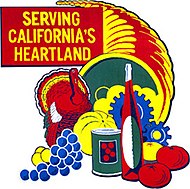Tidewater Southern Railway |
|
| Headquarters | Stockton, California |
|---|
| Reporting mark | TS |
|---|
| Locale | Central California |
|---|
| Dates of operation | 1910–1987 |
|---|
| Successor | Union Pacific |
|---|
|
| Track gauge | 4 ft 8+1⁄2 in (1,435 mm) standard gauge |
|---|
| Electrification | Overhead line, 1,200 V DC |
|---|
| Length | 85 mi (137 km)[1] |
|---|
|
|
|
|
|
|
|
|
Stockton
|
|
|
|
|
|
Washington Street 
|
|
|
|
|
|
Hazelton Avenue 
|
|
|
|
|
|
|
|
|
|
|
|
South Street 
|
|
|
|
|
|
Glass
|
|
|
|
|
|
Brickyard
|
|
|
|
|
|
|
|
|
|
|
|
Ortega
|
|
|
|
|
|
|
|
|
|
|
|
Manteca Junction
|
|
|
|
|
|
North Manteca
|
|
|
|
|
|
Manteca
|
|
|
|
|
|
South Manteca
|
|
|
|
|
|
Turner
|
|
|
|
|
|
Summer Home
|
|
|
|
|
|
Oak Point
|
|
|
|
|
|
Five Corners
|
|
|
|
|
|
Atlanta
|
|
|
|
|
|
Simms
|
|
|
|
|
|
Wagner 
|
|
|
|
|
|
Carrolton
|
|
|
|
|
|
Van Allen
|
|
|
|
|
|
Winetondale
|
|
|
|
|
|
Sexton
|
|
|
|
|
|
Volstead
|
|
|
|
|
|
Brennan 
|
|
|
|
|
|
Escalon
|
|
|
|
|
|
Ullery Avenue 
|
|
|
|
|
|
Jones 
|
|
|
|
|
|
Wigley 
|
|
|
|
|
|
Meyers
|
|
|
|
|
|
Gravel Pit
|
|
|
|
|
|
Stewart
|
|
|
|
|
|
McHenry
|
|
|
|
|
|
Bangs Avenue 
|
|
|
|
|
|
Standiford
|
|
|
|
|
|
Orangeburg Avenue 
|
|
|
|
|
|
Aurora
|
|
|
|
|
|
Coldwell Avenue 
|
|
|
|
|
|
Ice Plant Junction
|
|
|
|
|
|
|
|
|
|
|
|
N Street 
|
|
|
|
|
|
Modesto
|
|
|
|
|
|
|
|
|
|
|
|
Moore
|
|
|
|
|
|
Rogers
|
|
|
|
|
|
Harp
|
|
|
|
|
|
Grange
|
|
|
|
|
|
Gilman
|
|
|
|
|
|
Shoemake
|
|
|
|
|
|
Hatch
|
|
|
|
|
|
|
|
|
|
|
|
Leedom
|
|
|
|
|
|
Joyce
|
|
|
|
|
|
McGill
|
|
|
|
|
|
Cooper
|
|
|
|
|
|
Turlock
|
|
|
|
|
|
Chatom
|
|
|
|
|
|
Tegner
|
|
|
|
|
|
Ahlen
|
|
|
|
|
|
Hilmar
|
|
|
|
|
|
|
|
|
|
|
| |
|
The Tidewater Southern Railway was a short line railroad in Central California in the United States. For most of its history, it was a subsidiary of the Western Pacific Railroad. It was originally built as an interurban system, connecting to the Central California Traction Company, Western Pacific Railroad, Southern Pacific Railroad and Atchison, Topeka and Santa Fe Railway in Stockton, California. Its mainline went southeast from Stockton to Escalon, California and thence to Modesto, California before splitting into two branches ending at the towns of Turlock and Hilmar. Until the mid-1930s, there were plans to extend the line to Fresno and even toward the Los Angeles area. Today, much of the line is still operated by the Union Pacific Railroad. Of all the former interurban railroads in California, the former Tidewater Southern retains the highest percentage of still operating trackage.
